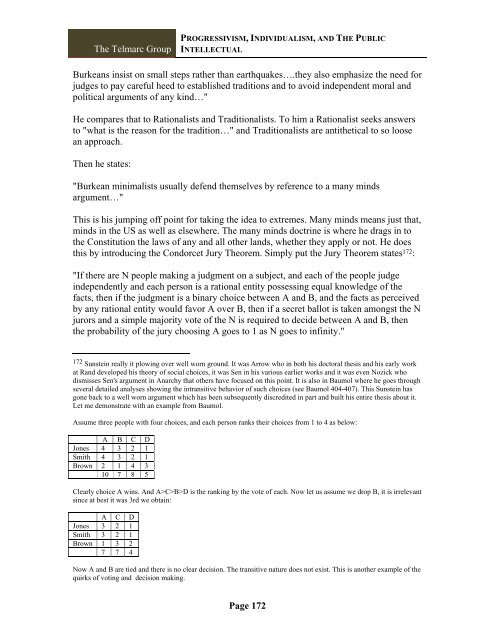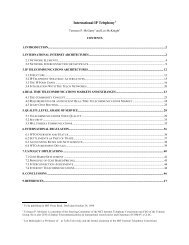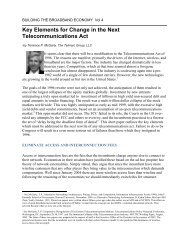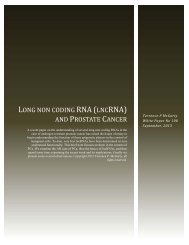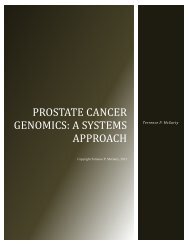progressivism, individualism, and the public ... - Telmarc Group
progressivism, individualism, and the public ... - Telmarc Group
progressivism, individualism, and the public ... - Telmarc Group
You also want an ePaper? Increase the reach of your titles
YUMPU automatically turns print PDFs into web optimized ePapers that Google loves.
The <strong>Telmarc</strong> <strong>Group</strong><br />
PROGRESSIVISM, INDIVIDUALISM, AND THE PUBLIC<br />
INTELLECTUAL<br />
Burkeans insist on small steps ra<strong>the</strong>r than earthquakes….<strong>the</strong>y also emphasize <strong>the</strong> need for<br />
judges to pay careful heed to established traditions <strong>and</strong> to avoid independent moral <strong>and</strong><br />
political arguments of any kind…"<br />
He compares that to Rationalists <strong>and</strong> Traditionalists. To him a Rationalist seeks answers<br />
to "what is <strong>the</strong> reason for <strong>the</strong> tradition…" <strong>and</strong> Traditionalists are anti<strong>the</strong>tical to so loose<br />
an approach.<br />
Then he states:<br />
"Burkean minimalists usually defend <strong>the</strong>mselves by reference to a many minds<br />
argument…"<br />
This is his jumping off point for taking <strong>the</strong> idea to extremes. Many minds means just that,<br />
minds in <strong>the</strong> US as well as elsewhere. The many minds doctrine is where he drags in to<br />
<strong>the</strong> Constitution <strong>the</strong> laws of any <strong>and</strong> all o<strong>the</strong>r l<strong>and</strong>s, whe<strong>the</strong>r <strong>the</strong>y apply or not. He does<br />
this by introducing <strong>the</strong> Condorcet Jury Theorem. Simply put <strong>the</strong> Jury Theorem states 172 :<br />
"If <strong>the</strong>re are N people making a judgment on a subject, <strong>and</strong> each of <strong>the</strong> people judge<br />
independently <strong>and</strong> each person is a rational entity possessing equal knowledge of <strong>the</strong><br />
facts, <strong>the</strong>n if <strong>the</strong> judgment is a binary choice between A <strong>and</strong> B, <strong>and</strong> <strong>the</strong> facts as perceived<br />
by any rational entity would favor A over B, <strong>the</strong>n if a secret ballot is taken amongst <strong>the</strong> N<br />
jurors <strong>and</strong> a simple majority vote of <strong>the</strong> N is required to decide between A <strong>and</strong> B, <strong>the</strong>n<br />
<strong>the</strong> probability of <strong>the</strong> jury choosing A goes to 1 as N goes to infinity."<br />
172 Sunstein really it plowing over well worn ground. It was Arrow who in both his doctoral <strong>the</strong>sis <strong>and</strong> his early work<br />
at R<strong>and</strong> developed his <strong>the</strong>ory of social choices, it was Sen in his various earlier works <strong>and</strong> it was even Nozick who<br />
dismisses Sen's argument in Anarchy that o<strong>the</strong>rs have focused on this point. It is also in Baumol where he goes through<br />
several detailed analyses showing <strong>the</strong> intransitive behavior of such choices (see Baumol 404-407). This Sunstein has<br />
gone back to a well worn argument which has been subsequently discredited in part <strong>and</strong> built his entire <strong>the</strong>sis about it.<br />
Let me demonstrate with an example from Baumol.<br />
Assume three people with four choices, <strong>and</strong> each person ranks <strong>the</strong>ir choices from 1 to 4 as below:<br />
A B C D<br />
Jones 4 3 2 1<br />
Smith 4 3 2 1<br />
Brown 2 1 4 3<br />
10 7 8 5<br />
Clearly choice A wins. And A>C>B>D is <strong>the</strong> ranking by <strong>the</strong> vote of each. Now let us assume we drop B, it is irrelevant<br />
since at best it was 3rd we obtain:<br />
A C D<br />
Jones 3 2 1<br />
Smith 3 2 1<br />
Brown 1 3 2<br />
7 7 4<br />
Now A <strong>and</strong> B are tied <strong>and</strong> <strong>the</strong>re is no clear decision. The transitive nature does not exist. This is ano<strong>the</strong>r example of <strong>the</strong><br />
quirks of voting <strong>and</strong> decision making.<br />
Page 172


